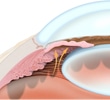Glaucoma is a group of related diseases that damage the optic nerve resulting in vision loss and blindness. Some of the diseases or conditions that contribute to the development of glaucoma include the following:
- Increased pressure within the eye
- Severe eye infection
- Injury to the eye
- Blocked blood vessels
- Inflammatory conditions of the eye
Glaucoma is a leading cause of blindness and visual impairment in the United States. Glaucoma can affect patients of all ages. Known as the "sneak thief of sight," many people affected with glaucoma do not experience any symptoms and may not be aware that they have the disease until they have lost a significant amount of vision. With early detection and treatment, eyes can be protected against the serious loss of vision or blindness.

Types of Glaucoma
There are several types of glaucoma.
Primary Open-Angle Glaucoma: Primary open-angle glaucoma, or POAG, is the most common type of glaucoma. The fluid in the eye drains too slowly through the network of tiny drainage channels, known as the trabecula. The pressure in the eye increases as the fluid in the eye continues to build. Loss of vision occurs gradually and vision loss is not always noticed until it becomes irreversible. About 95 percent of glaucoma cases are due to open-angle glaucoma.
Angle-Closure Glaucoma: Angle-closure glaucoma occurs when the tiny drainage channels, known as the trabecula, become blocked which then causes a sudden rise in pressure in the eye. This condition is not common but when it occurs it requires immediate medical attention.
Low Tension Glaucoma: Low tension glaucoma, or LTG, is a form of open-angle glaucoma. LTG occurs when the optic nerve is damaged despite the existing normal level of pressure in the eye. A reduction in the blood supply to the optic nerve may be the cause of this condition.
Congenital Glaucoma: Congenital glaucoma affects children who have a defect in the angle of the eye that causes the fluid to drain slowly from the eye. With prompt surgery, this condition can be corrected.
Secondary Glaucoma: Secondary glaucoma develops as a complication from another medical condition such as diabetes, cataract, eye tumor, eye injury or uveitis. Secondary glaucoma may also be the result of previous eye surgery.
Pigmentary Glaucoma: Pigmentary glaucoma occurs when pigment from the iris blocks the trabecula, resulting in the slower drainage of fluid.
Pseudoexfoliation Glaucoma: Pseudoexfoliation glaucoma develops when extra material in the eye blocks the trabecula, resulting in the slower drainage of fluid.
Risk Factors for Glaucoma
There are several factors that contribute to the risk of developing glaucoma. They include some of the following:
- Age
- Ethnicity
- Family history of glaucoma
- Myopia
- Hyperopia
- Thin corneas
- Elevated eye pressure
- Diabetes
- Low blood pressure
- Medication
- Eye injury
- Eye condition
Symptoms of Glaucoma
Symptoms of glaucoma vary depending on the type of glaucoma. Glaucoma can develop in one eye or both eyes. Some of the symptoms of two types of glaucoma are as follows:
Open-angle Glaucoma

- Blank spots in the vision that enlarge
- Loss of peripheral vision
- Tunnel vision in one or both eyes
Angle-closure Glaucoma

- Severe eye pain
- Nausea
- Vomiting
- Blurry vision
- Rainbow halos around lights
- Red eyes
- Headache
Diagnosis of Glaucoma
The diagnosis of glaucoma is determined after a comprehensive medical examination of the eye and a review of the patient's medical history. Tests will be conducted to confirm the diagnosis. Testing may include some of the following:
- Tonometry
- Dilated eye examination
- Visual field test (perimetry)
- Retinal evaluation
- Pachymetry
- Gonioscopy
- Visual acuity test
Treatment of Glaucoma
Once glaucoma has been diagnosed, treatment should begin as soon as possible to help minimize the risk of permanent vision loss. There is no cure for glaucoma, so treatment focuses on relieving symptoms and preventing further damage. Some of the treatment methods for glaucoma are as follows:
Medication: Eye drops or oral medication may be used to either reduce fluid production in the front of the eye or to help drain excess fluid. Side effects of the medication may result in redness, stinging, irritation or blurry vision. Patients should advise their doctor about any medications they are taking or any allergies they have to minimize the risk of side effects. While glaucoma often has no symptoms, regular use of the medication is needed to keep the eye pressure under control.
Laser Surgery: Trabeculoplasty, iridotomy or cyclophotocoagulation are procedures that aim to increase the outflow of fluid from the eye or eliminate fluid blockages through laser.
Surgery: A trabeculectomy may be used to create a new channel to drain fluid from the eye and reduce the pressure that causes glaucoma. Surgery is performed only after medication and laser procedures have been unsuccessful.
Preventing Glaucoma
There is no way to prevent glaucoma from developing. To prevent glaucoma from progressing, you may want to incorporate some of the following suggestions into your life:
- Get regular comprehensive eye examinations
- Get an annual screening for glaucoma
- Follow doctor-recommended treatment plan
- Make healthy lifestyle changes
- Protect eyes from injury

